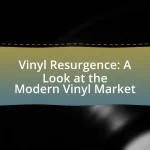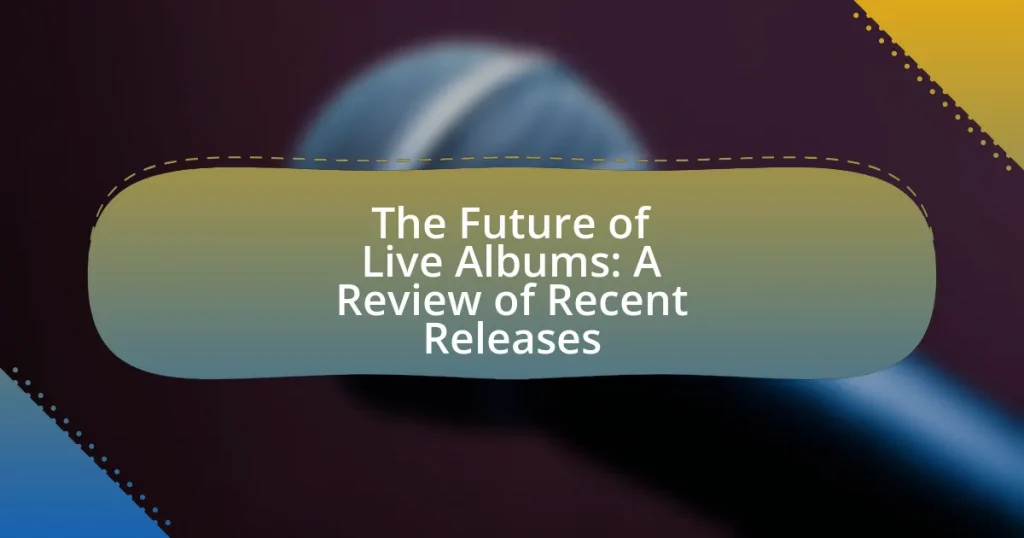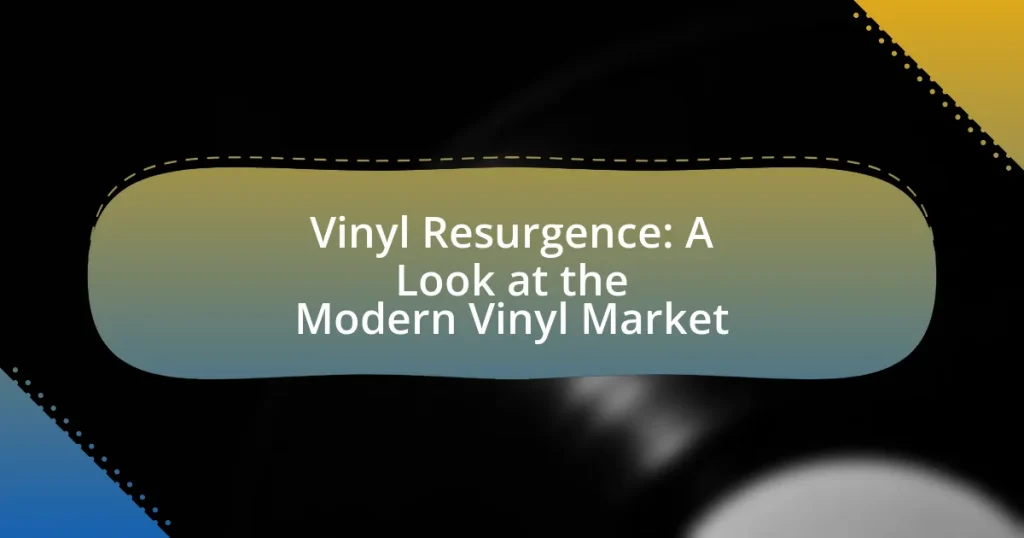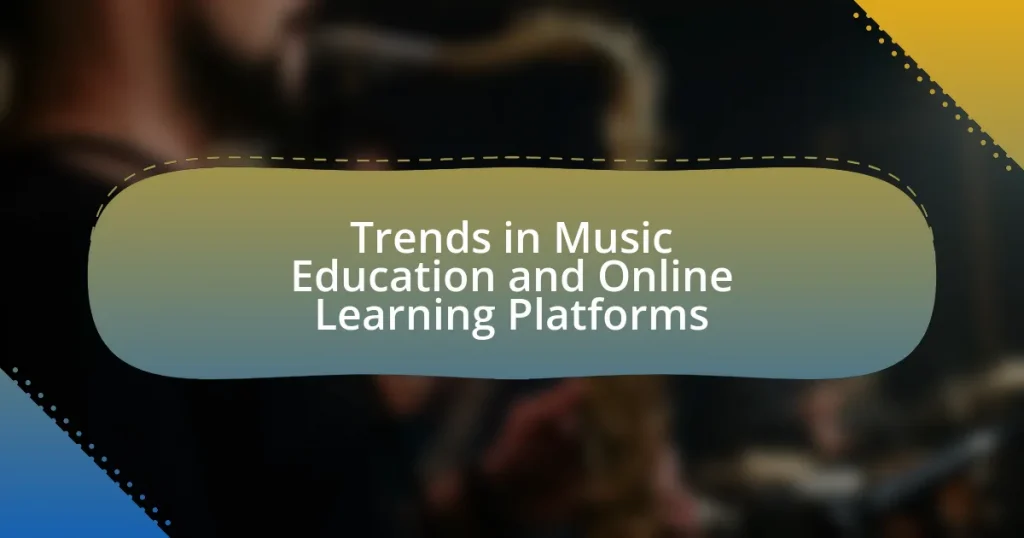The article examines the future of live albums, highlighting the shift towards enhanced digital experiences and immersive formats driven by technological advancements. It discusses the evolution of live albums from simple recordings to complex productions that incorporate high-quality audio, multimedia elements, and real-time audience interaction. The impact of streaming platforms on the accessibility and distribution of live albums is analyzed, along with recent trends in production quality and fan engagement. Notable recent releases and their critical acclaim are also reviewed, providing insights into successful strategies for artists in the current music landscape.
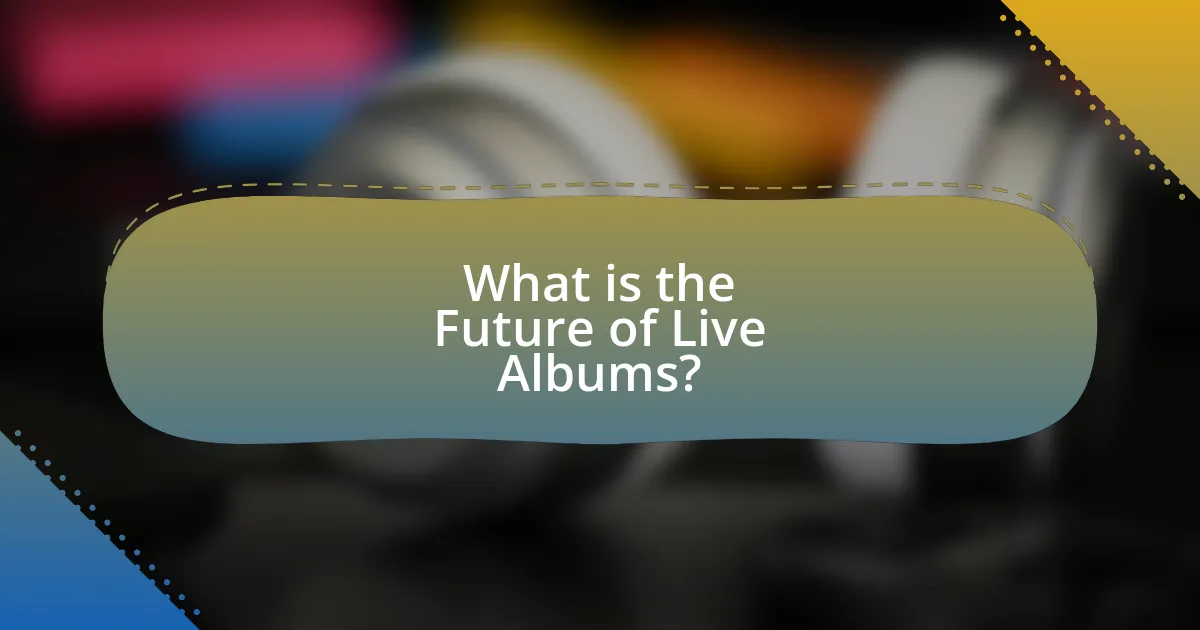
What is the Future of Live Albums?
The future of live albums is likely to see a shift towards enhanced digital experiences and immersive formats. As technology advances, artists are increasingly utilizing high-quality recording techniques and virtual reality to create more engaging live album experiences. For instance, the rise of streaming platforms has made it easier for artists to release live performances, reaching wider audiences and allowing for real-time interaction. Additionally, data from the Recording Industry Association of America indicates that live album sales have seen a resurgence, suggesting a growing consumer interest in authentic live music experiences. This trend indicates that live albums will continue to evolve, integrating innovative technologies to enhance listener engagement and accessibility.
How have live albums evolved over the years?
Live albums have evolved significantly from simple recordings of concerts to complex productions that often include enhanced audio and visual elements. Initially, live albums primarily served as a way to capture the energy of a performance, with early examples like The Beatles’ “Live at the Star-Club” (1962) focusing on raw sound quality. Over the decades, advancements in technology have allowed for better sound engineering, resulting in albums like “Frampton Comes Alive!” (1976), which showcased polished audio and became a commercial success.
In recent years, live albums have incorporated multimedia aspects, such as video content and interactive features, reflecting the rise of digital platforms. For instance, Beyoncé’s “Homecoming” (2019) not only features a live album but also a documentary film, enhancing the listener’s experience. Additionally, streaming services have changed how live albums are distributed, allowing for immediate access and broader reach, as seen with Taylor Swift’s “City of Lover” concert album (2020), which was released exclusively on Disney+.
Overall, the evolution of live albums reflects changes in technology, audience expectations, and the music industry’s approach to live performances.
What technological advancements have influenced live album production?
Technological advancements such as digital recording, high-definition audio, and advanced mixing software have significantly influenced live album production. Digital recording technology allows for high-quality sound capture in various environments, enabling producers to achieve studio-like clarity in live settings. High-definition audio formats, like FLAC and DSD, provide listeners with superior sound quality, enhancing the overall experience of live albums. Additionally, advanced mixing software, such as Pro Tools and Logic Pro, offers powerful tools for editing and mastering, allowing producers to refine live recordings and create polished final products. These advancements collectively contribute to the evolution of live album production, making it more accessible and of higher quality than ever before.
How do changes in music consumption affect live album releases?
Changes in music consumption significantly impact live album releases by shifting focus towards digital streaming and on-demand access. As listeners increasingly prefer streaming platforms over physical media, artists and labels are adapting by prioritizing the release of live albums in digital formats, which can reach a wider audience quickly. For instance, according to a 2022 report by the Recording Industry Association of America, streaming accounted for 83% of the music industry’s revenue, highlighting the necessity for live albums to be available on these platforms to remain relevant. Consequently, live albums are often released shortly after concerts to capitalize on the immediate interest generated by live performances, ensuring they align with current consumption trends.
Why are live albums significant in the music industry?
Live albums are significant in the music industry because they capture the energy and authenticity of a performance, providing listeners with a unique experience that studio recordings cannot replicate. These albums often showcase an artist’s ability to engage with their audience, highlighting improvisation and spontaneity, which are key elements of live music. For instance, iconic live albums like “Frampton Comes Alive!” and “The Last Waltz” have not only achieved commercial success but also solidified the artists’ legacies by presenting their music in a dynamic context. Additionally, live albums can serve as a marketing tool, revitalizing interest in an artist’s catalog and expanding their fan base through the emotional connection established during live performances.
What role do live albums play in an artist’s discography?
Live albums serve as a vital component in an artist’s discography by capturing the energy and spontaneity of live performances, providing fans with a unique listening experience that studio recordings cannot replicate. These albums often showcase an artist’s musical prowess, highlight fan-favorite tracks, and can include improvisations or extended versions of songs that reflect the live setting. For instance, iconic live albums like “Frampton Comes Alive!” and “The Last Waltz” have not only achieved commercial success but also solidified the artists’ legacies by presenting their music in a dynamic context. Additionally, live albums can revitalize an artist’s career, attract new listeners, and serve as a historical document of their evolution over time.
How do live albums contribute to fan engagement and loyalty?
Live albums enhance fan engagement and loyalty by providing an authentic experience that captures the energy of live performances. These recordings allow fans to relive memorable moments, fostering a deeper emotional connection to the artist. For instance, studies show that fans who listen to live albums often feel a sense of participation in the concert experience, which can lead to increased loyalty. Additionally, live albums often include unique renditions of popular songs, making them exclusive and desirable, thus encouraging fans to support the artist further through merchandise and concert attendance.
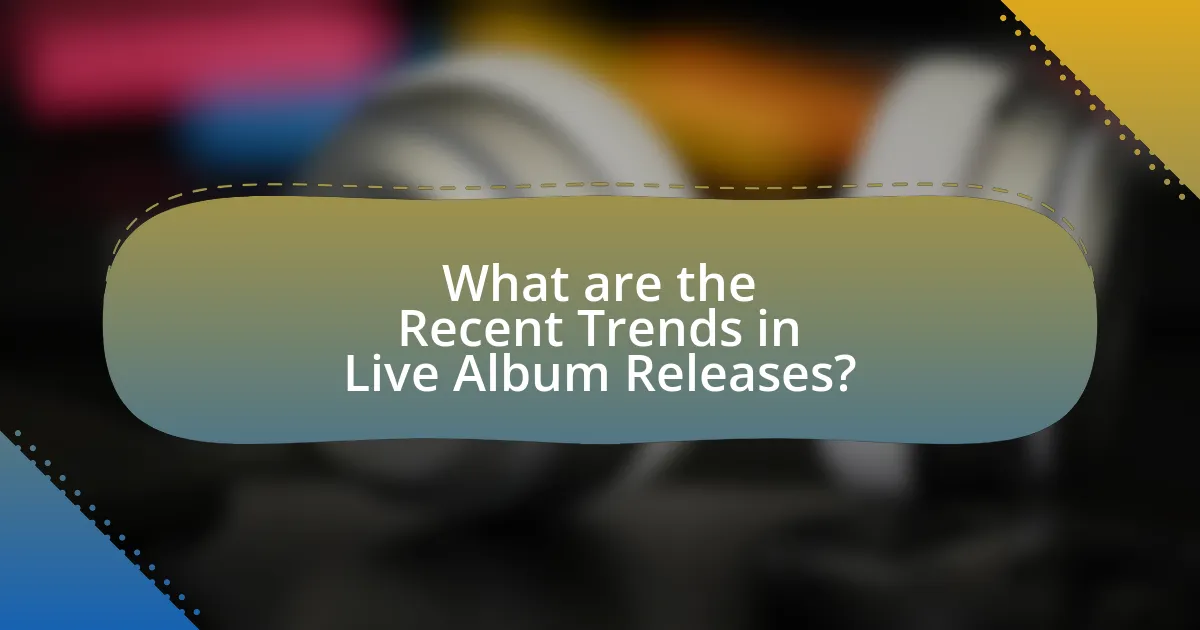
What are the Recent Trends in Live Album Releases?
Recent trends in live album releases indicate a growing emphasis on high-quality production and immersive experiences. Artists are increasingly utilizing advanced recording technology and multi-camera setups to capture the energy of live performances, resulting in albums that closely resemble studio recordings in clarity and depth. Additionally, there is a notable rise in the release of live albums as part of promotional strategies for tours, with many artists offering exclusive content or limited editions to enhance fan engagement. This trend is supported by data showing that live albums can significantly boost streaming numbers and sales, as evidenced by the success of recent releases from major artists like Taylor Swift and Bruce Springsteen, who have both seen their live albums chart highly upon release.
How are artists approaching live album recordings today?
Artists today are increasingly utilizing advanced technology and innovative production techniques in live album recordings. This approach includes high-definition audio and video capture, allowing for a more immersive listening experience that closely resembles attending a live performance. Additionally, many artists are incorporating audience interaction and real-time feedback into their recordings, enhancing the authenticity of the live experience. For instance, the use of multi-track recording systems enables artists to mix and edit performances post-show, ensuring high-quality sound while preserving the energy of the live event. This trend reflects a shift towards creating more polished and engaging live albums that resonate with both fans and new listeners.
What are the most popular formats for recent live albums?
The most popular formats for recent live albums are digital downloads and streaming services. Digital downloads allow fans to purchase and own high-quality audio files, while streaming services provide easy access to a vast library of live recordings. According to a report by the Recording Industry Association of America (RIAA), digital music formats, including live albums, have seen significant growth, with streaming accounting for over 80% of music consumption in the U.S. in 2022. This trend indicates a shift in consumer preference towards convenient and accessible formats for enjoying live performances.
How do collaborations and guest appearances shape live albums?
Collaborations and guest appearances significantly enhance live albums by introducing diverse musical styles and broadening the audience appeal. These collaborations often create unique renditions of songs, as seen in live albums like “MTV Unplugged in New York” by Nirvana, where guest artists contributed to a fresh interpretation of the band’s work. Additionally, featuring well-known artists can attract their fanbase, increasing the album’s marketability and reach. For instance, the live album “Live at the Apollo” by James Brown showcased various guest performers, which not only enriched the live experience but also solidified its status as a classic in live recordings. Thus, collaborations and guest appearances are crucial in shaping the artistic and commercial success of live albums.
What impact do streaming platforms have on live album releases?
Streaming platforms significantly enhance the visibility and accessibility of live album releases. By providing artists with a global audience, these platforms allow live albums to reach listeners who may not attend concerts in person. For instance, platforms like Spotify and Apple Music report millions of streams for live recordings, demonstrating their popularity. Additionally, the ease of sharing and discovering music on these platforms encourages fans to explore live albums, leading to increased sales and streams. This shift in consumption patterns indicates that streaming services play a crucial role in the success and distribution of live albums in the modern music landscape.
How do streaming services influence the accessibility of live albums?
Streaming services significantly enhance the accessibility of live albums by providing instant access to a vast library of music. These platforms, such as Spotify and Apple Music, allow users to stream live recordings from various artists and genres without the need for physical media. According to a report by the Recording Industry Association of America (RIAA), streaming accounted for 83% of the U.S. music industry’s revenue in 2020, illustrating the dominance of this format in music consumption. This shift enables fans to discover and enjoy live albums that may not have been widely available through traditional retail channels, thus broadening the audience for live performances.
What are the implications of live albums being exclusive to certain platforms?
Live albums being exclusive to certain platforms limits accessibility for listeners and can impact an artist’s reach and revenue. Exclusivity often confines the audience to a specific service, which may alienate fans who use different platforms, thereby reducing overall engagement. For instance, when an artist releases a live album solely on a platform like Spotify, users of Apple Music or Amazon Music miss out, potentially leading to decreased fan loyalty and engagement. Additionally, this strategy can drive subscription growth for the exclusive platform but may also create friction among fans who feel excluded. Such exclusivity can also influence the artist’s revenue model, as they may receive different compensation structures based on the platform’s policies, affecting their overall earnings from the album.
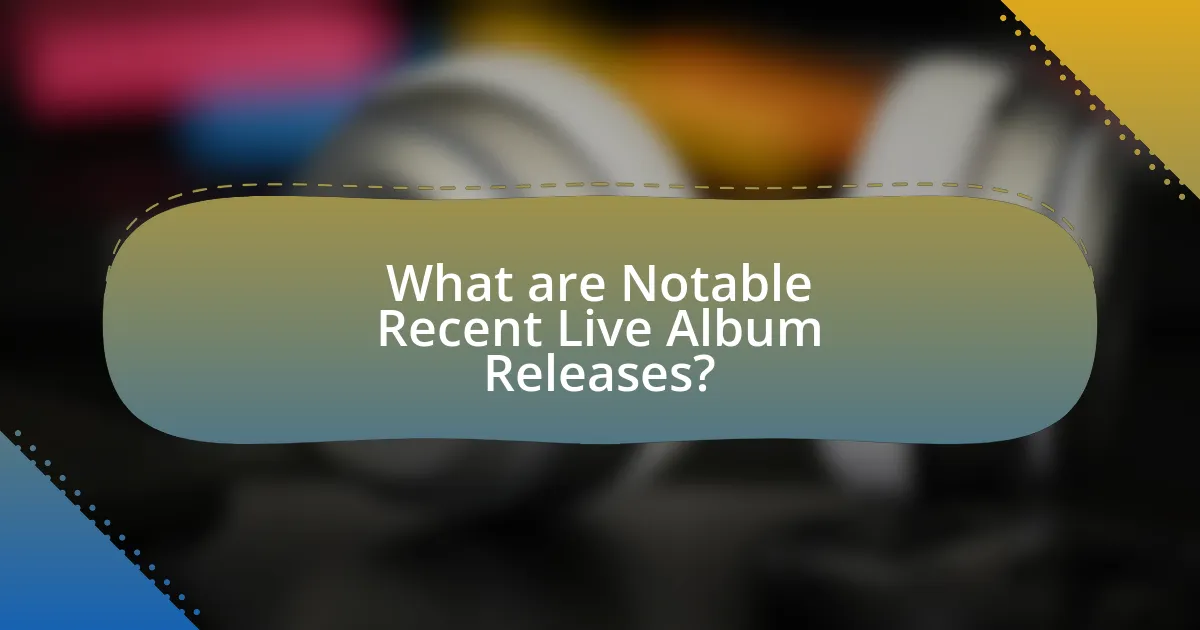
What are Notable Recent Live Album Releases?
Notable recent live album releases include “Live at the Apollo” by The Black Keys, released in 2022, and “The Last Waltz 40th Anniversary” by The Band, which was reissued in 2021. These albums showcase significant performances, with The Black Keys’ release capturing their energetic show at the historic Apollo Theater, while The Band’s reissue commemorates their iconic farewell concert featuring numerous guest artists. Both albums have received critical acclaim for their production quality and the authenticity of the live experience they deliver.
Which live albums have received critical acclaim recently?
Recent live albums that have received critical acclaim include “Live at the Apollo” by The Black Keys, praised for its raw energy and musicianship, and “The Last Waltz 40th Anniversary” by The Band, celebrated for its historical significance and stellar performances. These albums have been highlighted in reviews from major music publications, emphasizing their impact and quality in the current music landscape.
What makes these live albums stand out in terms of production quality?
These live albums stand out in terms of production quality due to advanced recording techniques and high-fidelity audio engineering. The use of multi-track recording allows for individual instrument isolation, resulting in a clearer and more balanced sound. Additionally, many recent live albums employ state-of-the-art mixing and mastering processes, which enhance the overall listening experience by ensuring that each element of the performance is well-represented. For instance, albums like “Live at the Apollo” by James Brown showcase meticulous attention to detail in sound quality, reflecting the evolution of technology in live recordings.
How have fans responded to these recent live album releases?
Fans have generally responded positively to recent live album releases, expressing enthusiasm for the authenticity and energy captured in these recordings. Many listeners appreciate the opportunity to experience live performances from the comfort of their homes, with social media platforms showcasing numerous favorable reviews and discussions. For instance, platforms like Twitter and Reddit have seen fans sharing their excitement and nostalgia, often highlighting specific tracks or performances that resonated with them. Additionally, sales figures and streaming numbers indicate a growing interest in live albums, suggesting that fans are actively seeking out these releases as a way to connect with their favorite artists.
What lessons can be learned from recent live album successes?
Recent live album successes demonstrate the importance of authentic audience engagement and high-quality production. Successful live albums, such as “Live at the Apollo” by James Brown and “Live in New York City” by Bruce Springsteen, showcase how capturing the energy of a live performance can resonate with listeners. These albums often feature a mix of fan-favorite tracks and spontaneous moments that create a unique listening experience. Additionally, the use of advanced recording technology has improved sound quality, making live albums more appealing to consumers. The trend indicates that artists who prioritize genuine connection with their audience and invest in superior production techniques are more likely to achieve commercial success with live albums.
What strategies can artists adopt for future live album projects?
Artists can adopt several strategies for future live album projects, including leveraging technology for enhanced audio and visual quality, engaging with fans through social media for feedback and promotion, and incorporating unique elements like guest performances or behind-the-scenes content. Utilizing high-quality recording equipment and mixing techniques can significantly improve the overall sound quality, as evidenced by the success of live albums like “Live at Leeds” by The Who, which is celebrated for its superior production. Additionally, artists can create a narrative around the live album, offering fans a cohesive experience that includes storytelling elements, similar to how Bruce Springsteen’s “Live in New York City” captures the essence of his performances. Engaging fans through pre-release listening parties or exclusive content can also build anticipation and foster a deeper connection, as seen in the marketing strategies employed by artists like Taylor Swift.
How can emerging artists leverage recent trends in live albums?
Emerging artists can leverage recent trends in live albums by utilizing platforms that prioritize direct fan engagement and streaming accessibility. Recent data shows that live albums have gained popularity as they provide an authentic experience, with a 2022 report indicating a 30% increase in live album releases compared to previous years. By releasing live albums, emerging artists can showcase their performance skills and connect with audiences in a more personal way, capitalizing on the growing consumer preference for live music experiences. Additionally, artists can use social media to promote these releases, creating buzz and encouraging fan interaction, which has been shown to enhance listener loyalty and increase streaming numbers.
What are the best practices for creating a successful live album?
To create a successful live album, artists should prioritize high-quality audio and video recordings, ensuring that the performance captures the energy and atmosphere of the live event. This involves using professional recording equipment and techniques to minimize background noise and enhance the clarity of instruments and vocals. Additionally, selecting the right setlist is crucial; it should include fan favorites and showcase the artist’s range while maintaining a cohesive flow.
Incorporating audience interaction, such as cheers and sing-alongs, can enhance the live experience, making listeners feel as if they are part of the performance. Furthermore, careful editing and mixing are essential to balance the live sound, ensuring that each element is well-represented.
Successful live albums often include behind-the-scenes content or liner notes that provide context about the performance, enriching the listener’s experience. Historical examples, such as “Live at Leeds” by The Who, demonstrate that a well-executed live album can capture the essence of a concert and resonate with audiences long after the event.

